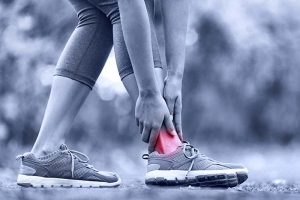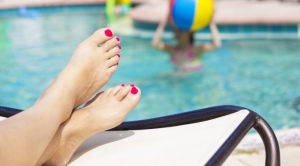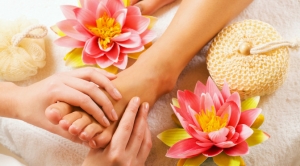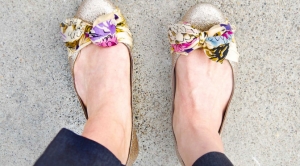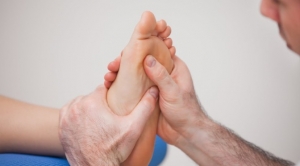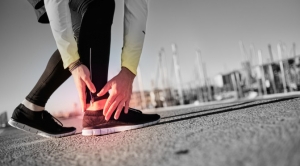Connect With Us
Blogs
Making Sure Your Ankle Heals Properly After Injury
If you have sustained a sprain or a fracture to your ankle, it is important to let it heal properly in order to avoid permanent damage. Ankle sprains are incredibly common: over 25,000 people suffer them every day. A sprain occurs when one or more ligaments on the outside of your ankle are pulled or torn. As it is hard to differentiate a sprain from a fracture, it is imperative to seek medical attention so that your ankle can be x-rayed. Once your injury has been diagnosed, you’ll be able to give it the care it needs in order for it to heal properly. Here are some tips for properly caring for your ankle injury to ensure that it heals correctly:
For a Sprain
Depending upon how serious the sprain is, the sprain can be classified as grade 1, 2, or 3. The best way to treat a sprain is to utilize the R.I.C.E. method: rest, ice, compression, and elevation. For a grade 1 sprain, you should rest your ankle by not walking on it as much as possible, only putting minimal weight on it. In many cases, an ankle brace will be given in order to help reduce the swelling and discomfort of a sprain, which may make it easier to put some weight on it if need be. However, if it is too difficult to bear weight, you may be given crutches. You can apply ice to help relieve the pain and swelling. When you ice your ankle, make sure that there is a barrier between the ice and your skin, such as a pillowcase or a towel. You shouldn’t ice your ankle for more than 20 minutes in order to avoid frostbite. Compression can help control the swelling, as well as provide your ankle with some support. Finally, you should elevate your ankle as much as possible by reclining and propping it up. It’s best to elevate your ankle either above your waist or your heart for optimal recovery.
With a grade 2 sprain, you would follow the same steps. While the grade 1 may take a week to heal, a grade 2 may take up to a month. Grade 3 sprains are rare and may require casting or surgery.
For a Fracture
If you fracture your ankle, your treatment will involve casting, taping, wrapping, or booting, depending upon the type and severity of the fracture. Much like a sprain, it is important to rest and elevate a fractured ankle. A fracture usually takes 4 to 8 weeks to heal. Once the cast comes off, you may have to follow the R.I.C.E. method until you regain strength in your ankle.
Rehabilitating Your Ankle
If you have a sprained or fractured ankle, you need to properly rehabilitate it in order to regain your full strength and flexibility. The first phase of rehabilitation is the R.I.C.E. method. The second phase is helping your ankle regain flexibility, strength, and range of motion by walking and putting weight on it. The last phase is exercising your ankle in order to strengthen the muscles and ligaments further.
Be sure to follow these steps to help your ankle heal properly. If you have any questions or concerns about your ankle injury, contact us today to schedule an appointment.
What to do if you Have a Toenail Fungal Infection
Dealing with a toenail fungal infection can be both difficult and unpleasant. When fungi attacks the nails, it can leave them yellowed, thick, split, and damaged. It can also leave you ditching your favorite pair of flip flops, or even hiding your feet in embarrassment when around other people. But aesthetics aside, nail fungus can have other, potential, effects that are even more concerning. Eventually, it’s possible for walking to become painful, or for the infection to spread. At which point, removing the nail might be necessary.
Unfortunately, this common condition doesn’t go way on its own. Instead, its capacity to get worse, and to impact your health, reveals that treatment, and preventative measures, are the keys to stopping a toenail infection from worsening.
The Fight Against Fungus
While you may have picked up the fungus from something as simple strolling around the pool barefoot, it’s not so simple to treat or eliminate it. This is one reason why early detection and treatment always remains the preferred route. That being said, steps towards getting rid of the infection can go in several directions.
You can’t deny that over the counter creams and topical applications offer convenience. Yes, it’s pretty natural to like the idea of purchasing a solution at your nearby drugstore. However, many of these products lack that ability to provide effective treatment is less reliable because many don’t penetrate deep enough to fully eradicate the fungus. The same can be said for plenty of home remedies. Seeking treatment from a professional foot doctor is often the best way to go and fight the good fight against fungus. A podiatrist will evaluate your condition and then based on the severity of the infection, go over your options.
Sometimes, a topical medication is a part of the plan. In other cases, these treatment methods may be recommended:
- The removal of thicker portions of the nail to provide pain relief (Debridement)
- Getting rid of the fungus using laser treatments
- Oral medications
Preventive Steps For Fungus-Free Feet
Even if you’ve kicked a fungal infection through treatment, it can come back. In order to keep it from returning and keep your feet healthy, here are several important steps to follow:
- Keep your feet clean: Wash them regularly with soap and water, then dry them thoroughly
- Keep your nails trimmed and make sure that toenail clippers, and grooming tools, are sanitized before using them.
- Wear clean shoes that are made of breathable materials
- Make sure to change your socks if they are dirty or damp
- Put on shower shoes in public areas, like a gym locker room or pool shower area.
Discovering Your Treatment Options
Toenail fungus may seem like a relatively small issue, but its capacity to get in between you, your lifestyle, and your foot health, is greater than you may realize. At Superior Foot & Ankle Care Center, we use our experience and knowledge to help patients with all kinds of foot-related problems, from the big to the seemingly small.
If you are dealing with nail fungus or another foot issue, please call us at 562-420-9800, today, or request an appointment at our Long Beach office. This is the first step to determining which course of treatment is right for you and what we can do to help you achieve happier, healthier feet.
The Health Benefits of Regular Foot Massages
There are many physical and psychological health benefits related to foot massages. Daily foot massages, for a couple minutes at a time, has been proven to fight depression and relieve headaches. Here is a list of the many health benefits of having regular foot massages.
Stress Relief
Regular foot massages have been shown to greatly relieve stress, as well as, many of the symptoms associated with it, such as energy loss and headache. A five to ten-minute foot massage, after a long day, can significantly relieve fatigue and increase feelings of well-being. Try using scented oil when administering your foot massage, for the added benefit of aromatherapy.
Blood Circulation & Sleep
Poor blood circulation causes many foot health issues. Regular foot massages can regulate your blood flow and keep your feet healthy, as well as, combat foot health problems such as inflammation, swelling, and pain. Foot massages also stimulate the limbic system and help prevent varicose veins. When night falls, massaging your feet right before bed helps you unwind, relax your nerves, and relieve any aches and pains-promoting restful sleep. Try using a lavender scented oil when administering your foot massage, as the lavender scent in calming and promotes relaxation.
Foot Health
Not only does regular foot massage promote healthy blood circulation, it can also relieve everything from minor aches to arthritis pain. In addition, it has been shown that regular foot massages, with olive or coconut oil, can significantly relieve the pain associated with foot tendonitis. Additionally, daily foot massage can help strengthen your ankles and increase your flexibility, which can prevent foot-related injuries.
Pain & Depression
While it’s well known that foot massages relieve foot pain, it also an effective way to treat other common body aches and pains. For example, regularly massaging your ankle and Achilles tendon can help relieve lower back pain and pressure. Additionally, because foot massage is such an effective stress relief treatment, it has also been shown to relieve migraine and headache pain. Regular foot massages also help you feel relaxed and balanced, promoting a sense of calm. Considering stress, tension and fatigue are associated with situational depression, daily foot massages have been shown to not only combat to these symptoms, but depression itself.
Other Health Benefits
- Helps manage PMS and Menopause symptoms.
- Assists those suffering from restless leg syndrome manage their illness.
- Relieves swollen feet during pregnancy.
- Relieves the chronic pains of arthritis in the feet and legs.
- Helps those with minor foot injuries to heal quicker.
Now that you are aware of the health benefits from regular foot massages, be sure to incorporate this into your daily routine, along with your regular visits to Superior Foot & Ankle Care Center. If you have any questions or concerns about your foot health, please feel free contact us today, at 562-420-9800.
Foot Health Tips for Athletes
Athletes are busy people. Whether they’re students balancing homework and extracurricular activities, or 9-5 workers trying to stay in shape in the evenings, athletes only have limited time for everything else. Focus on diet, exercise, and responsibilities, foot health is one of the last things on an athlete’s list of concerns. If you or someone in your family leads an active lifestyle, make sure they’re taking the time to take heed of the following foot care tips.
Shoes
If you’re devoted to a particular sport, you probably have a great pair of sport-specific shoes already. If for some reason you don’t, or you’re planning to start playing a new sport regularly, make sure that you get a specialized pair, soon. Basketball shoes, for example, have a very particular type of cushioning designed for rapid changes in direction and hard landings. If your shoes don’t fit well or aren’t designed for the activity, you could be risking injury.
When looking for shoes, shop in the afternoon or later, when your feet swell to their largest size. And one more thing: shoes tend to lose shock absorption between 250-500 miles. Runners who go for 25 miles every week will need new shoes, every 2.5-5 months.
Socks
Any old pair of socks might seem to do the trick, but believe it or not, those fancy Nike or Underarmor logo socks really do have a purpose. If your socks aren’t made with moisture-wicking fabric, the fabric will retain moisture for too long and may cause blisters.
College students, stay on top of your laundry: if you don’t change your socks often, you could develop foot odor.
Blisters, and Calluses
Speaking of blisters, don’t ever pop them. If they happen to pop, wash the area, apply antiseptic, then apply a bandage.
As for calluses, talk to your doctor before making a decision. Don’t try to remove them on your own, even if you have an over-the-counter product.
Toenails
Make sure toenails are trimmed to avoid in-grown nails. Cut the nails straight across, but leave them slightly longer at the end of each toe. Watch out if they turn black or blue; it could be a sign of blood underneath the nail, or possibly a condition like melanoma or an infection.
That should cover most (if not all) potential foot problems. If you take nothing else from this article, remember to practice proper hygiene, and use proper sports shoes and socks.
Feel free to contact us you have any further questions and concerns about your foot health. For a consultation, call Superior Foot & Ankle Care Center, at 562-420-9800, to set up an appointment today.
Ways you can get Involved at the Special Olympics
Inclusivity and community are at the heart of the Special Olympics. Keeping in line with that spirit is why so many people can become involved in the organization, in several ways. Here at Superior Foot & Ankle Care Center, our participation has mainly been related to the health side of things. It could be said that, when these games are “afoot,” we help to keep foot health a priority. We do this by performing screenings that make sure participants are wearing proper shoes before they compete, and by offering our expertise and advice concerning foot-related problems. But for those of you who aren’t involved in health services, there are many other opportunities in which you can participate. Check out these ways you, or someone you know, can join in the fun and get involved in the movement:
Be a Coach/Official:
Whether it comes to motivating and teaching, or ensuring that the rules are implemented, coaches and officials are both integral parts of the Special Olympics. As the games and the number of its participants continue to grow, this is one area that could use more people to lend a helping hand.
Volunteer:
All over the world, Special Olympics offices need volunteers to help make them be the best that they can be. This can include things like meeting with the athletes and training them in various sports, or talents, such as photography, to capture the essence of the events and the heart of the competitors. Event organizers and fundraisers are also needed.
Participate:
Unified partners are those who play sports alongside athletes with intellectual disabilities. Like others involved, these participants get to experience the joy of the human spirit, when everyone works together. Help break down stereotypes and build up unity by joining the team!
Become an Athlete:
Children, ages 8 and up, with an intellectual disability are encouraged to become involved as an athlete and join in theses exciting events. For children, ages 2-7, the Youth Athletes program is available. At any skill level, athletes can become enriched by new friends and new challenges. Many have gained confidence and leadership skills that have led them to roles in coaching, mentoring, and public speaking.
Helping Acceptance Go Strong & Helping Feet Get Happy
Taking part in an organization like the Special Olympics can be a very rewarding experience, for all involved. It can work to create a better world where acceptance, friendship, and community can thrive. Learn how you can be a part of this process today.
Foot issues can have a big impact on everything from participating in sports, to volunteering, to the overall quality of life. If you are suffering from any of these problems, please contact our Long Beach office for help that can get your feet back on a happy, healthy track.
Great Foot Care Tips for Diabetics
Diabetics, generally, have a lot of tasks on their daily agenda. In order to stay healthy and control their disease they go through routines that include monitoring blood sugar levels, eating a balanced diet, exercising, and sticking to a medication plan. Besides all of that, there is another critical thing they must do: pay attention to their feet.
The undeniable importance of diabetic foot care stems from the effects the disease can have on the body. Nerve damage caused by increased blood sugar levels can result in a loss of feeling in the feet. When dealing with another affect of poor circulation, a dangerous combination is formed. Cuts and blisters that would normally be noticed, can then go unfelt. If left untreated, an infection can set in due to the lack of blood flow and ability to properly heal.
Refraining taking the necessary steps to actively care for your feet, what may start as a minor issue can develop into a seriously situation, one that may lead to hospitalization and a possible an amputation.
Five Essential Foot Care Tips
Check Feet on a Daily Basis: This may seem simple, but it requires a certain level of dedication and diligence. Diabetics should inspect their feet for things like corns, infected toenails, areas of redness, and calluses. Through this self-assessment, early diagnosis is possible and further complications can be prevented.
Don’t Go Bare foot: Protect your feet from potential injuries such as cuts and burns by wearing shoes and socks. On the same note, shoes should be supportive, cushioned, and fit properly.
Encourage Blood Flow: Each day, those with diabetes should move their toes and ankles around to aid in proper circulation. They should also walk and stand whenever possible. Sitting with crossed legs should be avoided, and smoking cigarettes should be stopped, as it can diminish blood flow.
Maintain Properly Groomed Feet: To lessen the risk of infection, feet should be cleaned and dried daily. Afterwards, toenails should be trimmed and cut straight across.
Avoid Extremes: Since nerve damage can cause numbness in the feet, extreme temperatures may not be noticeable. Precaution in this area first involves checking water temperature, with the elbow, before putting feet in hot or cold water. Feet should also be kept warm with socks during the night or in cold weather.
Keeping Diabetic Feet Happy & Healthy
All of these tips work together to make sure diabetics stay on the top of their game when it comes to caring for their feet. Knowing what the positive impact proper foot care can have on health, regular checkups with a podiatrist are recommended and immediate medical attention should be sought if concerning issues like a cut occurs.
At Superior Foot & Ankle Care Center, we offer the highest level of medical knowledge and skill that diabetic patients need. From treatments and exams, to footwear selection assistance and care instruction, our goal is to help ensure feet stay happy and healthy for a lifetime. If you are diabetic and would like to remain on the right track with your foot health, contact our office in Long Beach today.
Gout: Its Causes and Treatments
How to Identify and Treat Gout
For many people, a life full of “extremes” is a highly enjoyable one. Just ask the lovers of extreme sports, foods, or fitness. However, it’s another thing altogether when it comes to the element of extreme pain. Gout, a form of inflammatory arthritis, can be the cause of such intense pain that the result is debilitating. Along with swelling and redness, the excruciating pain often initially occurs in the joint at the base of the big toe, but it can attack other joints as well. This attack can flare-up without warning in the middle of the night, or strike suddenly upon rising out of bed in the morning.
What Causes it?
Unfortunately, gout is hardly an uncommon condition. It affects millions, about 4% of the nation’s adult population, and occurs more often in men ages 40 to 60. Women are also at risk however, and are especially susceptible to developing gout after menopause.
So, what causes the disease? To sum it up, gout is caused by an excess amount of uric acid in the blood. Uric acid is produced when chemicals called purines, which are naturally found in the body and in certain foods, are broken down. In a normal situation, the uric acid would merely be dissolved in the body or passed through into urine. However, when too much is being produced or an insufficient amount is being eliminated by the kidneys, the uric acid then accumulates and crystallizes. These urate crystals are sharp and can cause inflammation and pain as they form in the joint.
Common Risk Factors
The tendency to develop gout can be linked to several different factors. One example being that the painful disease may occur due to genetics and a family history. Diet can also play a big part in gout flare-ups. Consuming certain foods and drinks that contain high levels of purines, like red meat, shellfish, and alcohol can lead to the formation of urate crystals. Other possible contributors to gout include:
- Obesity
- Certain medications like diuretics and aspirin
- Age & gender
- Other health issues such as diabetes and high-blood pressure
- Chemotherapy
- Trauma or recent surgery
Treatment
While it’s true that the symptoms of gout can be extremely painful, the good news is that it is a treatable and controllable condition. While many attacks of gout last about 10 days before disappearing, it’s important to seek treatment early on so that uric acid levels can be monitored and steps can be taken to prevent the disorder from worsening.
After examining the affected joint, a podiatrist or doctor typically runs a few tests to make sure that uric acid/urate crystals are the cause of the symptoms and then proceed with different treatment steps.
Most often, medications are prescribed to alleviate the pain associated with this type of arthritis, and to reduce possible gout complications like kidney stones. Lifestyle changes and other methods may also prevent painful gout flare-ups or the condition occurring in the first place. These can include:
- Avoiding alcohol
- Limiting meat and fish consumption
- Keeping hydrated with water and other fluids
- Elevation to relieve inflammation
- Maintaining a healthy weight
Treatment and preventative measures really are key, because otherwise, gout may result in the inability to wear shoes and socks because of the inflammation and soreness, or reoccurring attacks of burning pain and even joint damage.
Gout Pain Relief With Superior Care
The truth is that gout is no laughing matter. Instead, it’s the source of one extreme that better left off of life’s to-do list; pain. If you are experiencing attacks of gout, or another type of foot problem, request an appointment with Superior Foot & Ankle Care Center in Los Angeles today. Together, our team of experienced foot doctors and staff strive to help each patient achieve feet that are both healthy and happy, to the extreme.
Congratulations to Dr. Ornelas
Weak Ankles: How to Strengthen Them
Strengthening Weak Ankles for Walking, Hiking or Running
A firm foundation is more important than many people may even realize. Working together as a powerful team, the foot and the ankle provide balance, support and mobility to the body, helping to form a strong base and keeping it on the go. When an instrumental component to this structure becomes weakened, it can put limitations on a person’s involvement in the activities that they love. Weak ankles are a prime example of this, and for men and women alike, it can be the main factor that prevents them from joining in on a fun game of soccer, going on a hike or a run, or merely accomplishing the tasks of day to day life with a normal degree of comfort and stability.
Causes & Symptoms
Oftentimes, a person’s ankles can become unstable as a result of previous injuries, congenital causes or repeated ankle sprains. A common feeling is an unsteadiness or a giving out of the joint. It is also fairly typical for individuals with weak ankles to favor the lateral part of their feet, leaving the legs and feet feeling tired or exhausted by the end of the day. The situation can worsen by rolling the ankle, which can cause swelling, tenderness and pain.
Ways to Strengthen Your Step
It can be said that weak ankles are a part of a vicious cycle. Commonly caused by injury, they then subsequently increase the risk for further missteps, injuries, or sprains. Like many other foot issues, discovering the best method of treatment is most suitably done after a podiatrist examines the foot and determines the exact source of the problem. However, in general, performing these basic stretches and exercises every other day can help to strengthen the ankle-supporting muscles that have been weakened, and promote stability, flexibility and future sprain prevention:
Balancing Stance – Stand on one foot and balance yourself. This works the supporting muscles of the ankle as it shifts to remain stable during the pose. Then switch feet and repeat the exercise. You can also try this while holding hand weights to further build up the muscles.
Heel Raises & Walks – Stand with feet shoulder width apart and slowly lift yourself up on your toes. Hold briefly and then lower the heels down to the starting position. Do this for 10-15 reps. If you find this too difficult, hold onto the back of a chair for support. To increase the challenge and muscle strengthening, try the exercise while holding weights. Another muscle strengthening exercise is to balance yourself on your heels and walk around the room.
Resistance Exercises – At Superior Foot & Ankle Care Center, we offer Thera-Band products such as resistance bands to help patients improve range of motion and muscle cooperation. These bands can be used to strengthen weak ankles through simple exercises. For example, in one exercise, sit on the floor and wrap an end of the band around the foot. Grab the other end with both hands and push your foot forward. Then return to the original position. Do this for about 15 to 20 reps. You can also try tying the band to a stable fixture. Once seated, wrap the other end around your foot. Then flex the toes inwards against the band.
Keeping Your Feet Healthy & Your Ankles Strong
For hikers, runners and athletes, keeping ankles strong is extremely necessary to maintain their performance and level of activity. But overall, weak ankles can have an impact on those of any pursuit, coming in between doing the things they enjoy and making further injury a bigger risk. If you have concerns about your ankle pain or another foot problem, request an appointment at Superior Foot & Ankle Care Center in Long Beach today. We provide the highest standard of care to treat each patient with their individual symptoms and needs. Viewing surgery as a last resort, we put our podiatry knowledge to good use, so our patients can put their best foot forward through life.
Congratulations to Dr. Connie!
A Big Congratulation to Dr. Connie!
We couldn’t be more thrilled to share in the joy of Dr. Connie’s upcoming bundle of joy. We have been blessed to have her here with us at Superior Foot & Ankle Care Center. Her expertise in podiatric surgery has been invaluable, and her wonderful personality has always been a great source of joy for our patients, as well as our staff.
Dr. Connie Enjoying a Great Time at the Baby Shower

Recently, we were able to say thank you and to celebrate the arrival of her upcoming baby with a wonderful baby shower. Friends, colleagues and extended “family” (here’s Dr. Vikki’s mom with Dr. Connie at the shower) came together to celebrate this time of joy in Dr. Connie’s life.
She’s having a…
And for all of you wondering if she’s having a boy or a girl; well, we’ll let the last picture be the answer to that.

